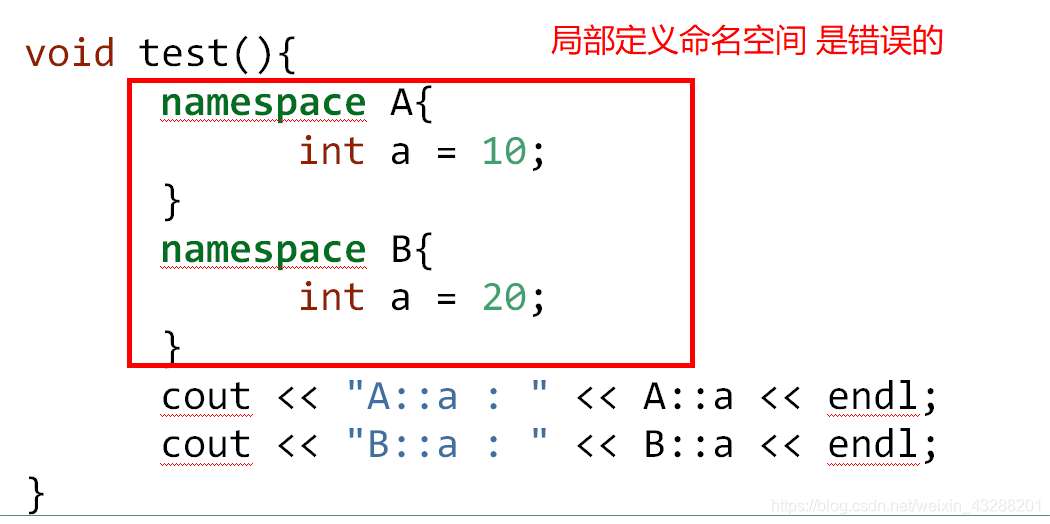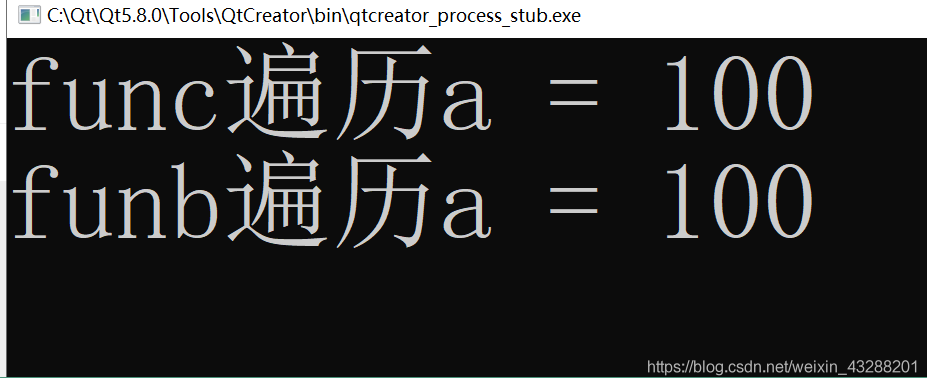命名空间
- 命名空间 namespace
- 1、::作用域运算符(表明 数据、方法 的归属性问题)
- 2、命名空间 namespace 解决命名冲突
-
- 2.1:namespace命名空间的定义
- 2.2:命名空间只能全局范围内定义(以下错误写法)
- 2.3:命名空间可嵌套命名空间
- 2.4:命名空间是开放的,即可以随时把新的成员加入已有的命名空间中(常用)
- 2.5:命名空间 可以存放 变量 和 函数
- 2.6:命名空间中的函数 可以在“命名空间”外 定义
- 2.7:无名命名空间,意味着命名空间中的标识符只能在本文件内访问,相当于给这个标识符加上了static,使得其可以作为内部连接
- 2.8:给命名空间 取个别名
- 3. using 使用命名空间
-
- 3.1、简化了从命名空间的成员访问
- 3.2、using 使用整个命名空间
- 3.3、using 指明使用具体的命名空间 成员。(了解就可以)
- 3.4、using声明碰到函数重载(了解)
- 3.5、不同命名空间中的 同名成员 使用的时候注意 二义性
- 总结:
命名空间 namespace
1、::作用域运算符(表明 数据、方法 的归属性问题)
using namespace std;
int a = 10;//全局变量
void test01()
{
int a = 20;//局部变量
cout<<"局部变量a = "<<a<<endl;//优先选择局部变量
//::作用域运算符(c++独有)
cout<<"全局变量a = "<<::a<<endl;//取全局变量
}
2、命名空间 namespace 解决命名冲突
2.1:namespace命名空间的定义
namespace 可以自己修改或创建
//定义一个名字为A的命名空间(变量、函数)
namespace A {
int a = 100;
}
namespace B {
int a = 200;
}
void test02()
{
//A::a a是属于A中
cout<<"A中a = "<<A::a<<endl;//100
cout<<"B中a = "<<B::a<<endl;//200
}
2.2:命名空间只能全局范围内定义(以下错误写法)

2.3:命名空间可嵌套命名空间
namespace A {
int a = 1000;
namespace B {
int a = 2000;
}
}
void test03()
{
cout<<"A中的a = "<<A::a<<endl; //1000
cout<<"B中的a = "<<A::B::a<<endl; //2000
}
2.4:命名空间是开放的,即可以随时把新的成员加入已有的命名空间中(常用)
namespace A {
int a = 100;
int b = 200;
}
//将c添加到已有的命名空间A中
namespace A {
int c = 300;
}
void test04()
{
cout<<"A中a = "<<A::a<<endl;//100
cout<<"A中c = "<<A::c<<endl;//200
}
2.5:命名空间 可以存放 变量 和 函数
namespace A {
int a=100;//变量
void func()//函数
{
cout<<"func遍历a = "<<a<<endl;
}
}
void test05()
{
//变量的使用
cout<<"A中的a = "<<A::a<<endl;
//函数的使用
A::func();
}
2.6:命名空间中的函数 可以在“命名空间”外 定义
namespace A {
int a=100;//变量
void func();
}
void A::func()//成员函数 在外部定义的时候 记得加作用域
{
//访问命名空间的数据不用加作用域
cout<<"func遍历a = "<<a<<endl;
}
void funb()//普通函数
{
cout<<"funb遍历a = "<<A::a<<endl;
}
void test06()
{
A::func();
funb();
}
运行结果:

2.7:无名命名空间,意味着命名空间中的标识符只能在本文件内访问,相当于给这个标识符加上了static,使得其可以作为内部连接
namespace{
int a =10;
void func(){
cout << "hello namespace "<< endl}
}
void test(){
cout << "a:" << a << endl;
func();
}
2.8:给命名空间 取个别名
namespace veryLongName{
int a = 10;
void func(){
cout << "hello namespace" << endl; }
}
void test(){
namespace shortName = veryLongName;
cout << "veryLongName::a : " << shortName::a << endl;
veryLongName::func();
shortName::func();
}
3. using 使用命名空间
3.1、简化了从命名空间的成员访问
namespace veryLongName {
int a=100;
void func(){
cout<<"hello namespace"<<endl;}
}
void test07()
{
//使用veryLongName命名空间
using namespace veryLongName;
//出现的变量 从veryLongName命名空间中找 找不到 从其他地方中
cout<<"a = "<<a<<endl;
func();
}
3.2、using 使用整个命名空间
namespace veryLongName {
int a=100;
void func(){
cout<<"hello namespace"<<endl;}
}
void test07()
{
int a=200;
//使用veryLongName命名空间
using namespace veryLongName;
//出现的变量 从veryLongName命名空间中找 找不到 从其他地方中
cout<<"a = "<<a<<endl;//访问的是局部变量中的a
cout<<"a = "<<veryLongName::a<<endl;//访问的是veryLongName的a
func();
}
3.3、using 指明使用具体的命名空间 成员。(了解就可以)
using直接使用 命名空间中的成员 会和 局部变量冲突
namespace veryLongName {
int a = 100;
void func(){
cout << "hello namespace" << endl;}
}
void test01()
{
//using直接使用 命名空间的成员会和局部变量冲突
int a = 200;
//指明 使用命名空间中的具体成员 容易和其他变量冲突
using veryLongName::a;//err
cout << "a = " << a << endl;
//但是func使用的时候 必须加作用域
veryLongName::func();
}
using直接使用 命名空间中的成员 不会和 全局变量冲突
namespace veryLongName {
int a=100;
void func(){
cout<<"hello namespace"<<endl;}
}
int a = 200;
void test07()
{
//using直接使用 命名空间中的成员 不会和 全局变量冲突
using veryLongName::a;
cout<<"命名空间中a = "<<a<<endl;//命名空间中的成员 100
cout<<"全局变量中a = "<<::a<<endl;//200
//但是func使用的时候 必须加作用域
veryLongName::func();
}
3.4、using声明碰到函数重载(了解)
namespace A {
//函数重载 函数名+参数 组合代表是函数的入口地址
void func(){
cout<<" 无参的func"<<endl;}
void func(int a){
cout<<" int的func"<<endl;}
void func(int a,int b){
cout<<" int int的func"<<endl;}
}
void test08()
{
//using指明 使用 A中的func 会对 所有的func起作用
using A::func;
func();
func(10);
func(10,20);
}
运行结果:

3.5、不同命名空间中的 同名成员 使用的时候注意 二义性
namespace A {
int a = 10;
}
namespace B {
int a = 20;
}
void test09()
{
//此处的a 不知道是A还是B中a
//cout<<"a = "<<a<<endl;//err
//解决方法
cout<<"A::a = "<<A::a<<endl;//100
cout<<"B::a = "<<B::a<<endl;//200
}
总结:
namespace A
{
int a = 10;
void func(){
cout<<"func"<<endl;}
}
1、命名空间的定义( 不能在 函数内 定义命名空间)
2、使用命名空间的成员 最安全的方式 命名空间名::成员名
3、using namespace 命名空间名;使用整个命名空间 (重要)
using namespace A;
4、单独 使用命名空间中的具体成员:using 命名空间名::成员名;
using A::a;
5、说明一下main中的std
#include <iostream>
//使用标准的命名空间std
//std中所有成员名 可以直接使用
//cout endl cin都是命名空间std的成员
using namespace std;
int main(int argc, char *argv[])
{
std::cout << "Hello World!" << std::endl;
cout << "Hello World!" << endl;
return 0;
}

 菜鸟笔记
菜鸟笔记